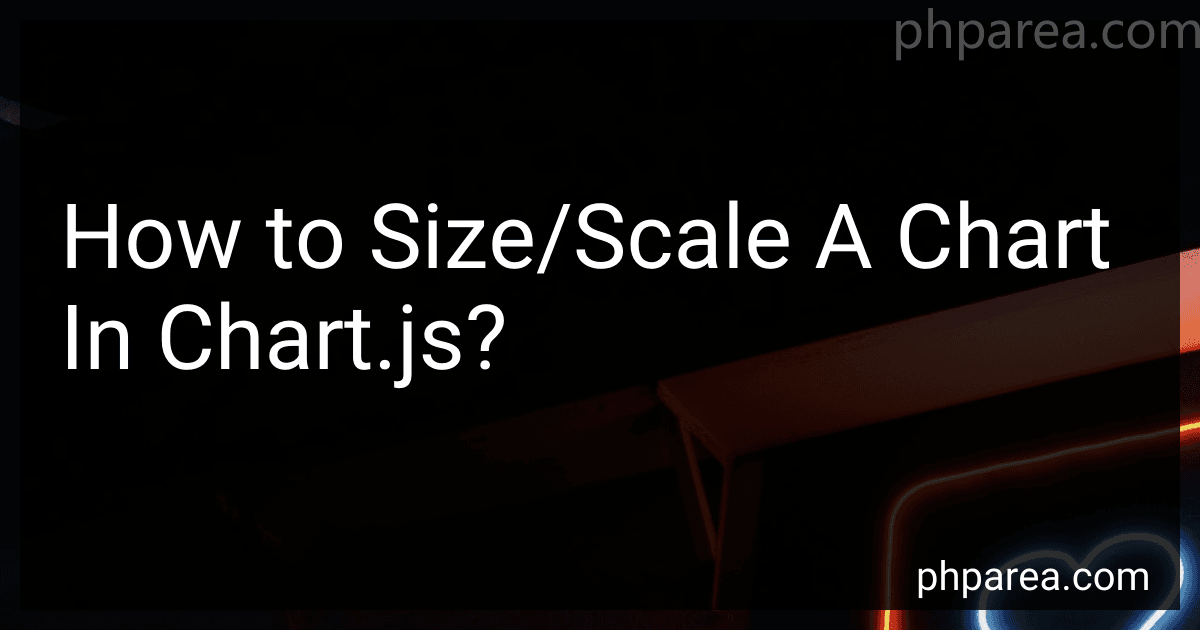Posts (page 69)
-
 5 min readTo add a custom plugin to Chart.js, you will need to first create the plugin according to your specific requirements. This can include adding additional functionality, styling, or interactions to your charts.Once you have created and tested your custom plugin, you can add it to your Chart.js configuration by including it in the plugins section of the chart options. You can either include the plugin directly as an object, or import it as a module if you are using a module bundler like Webpack.
5 min readTo add a custom plugin to Chart.js, you will need to first create the plugin according to your specific requirements. This can include adding additional functionality, styling, or interactions to your charts.Once you have created and tested your custom plugin, you can add it to your Chart.js configuration by including it in the plugins section of the chart options. You can either include the plugin directly as an object, or import it as a module if you are using a module bundler like Webpack.
-
 4 min readTo change the label color in Chart.js, you can use the options object in your chart configuration. Within the options object, specify the scales property, and then define the yAxes property to access the y-axis options. Within the y-axis options, there is a ticks property where you can define the fontColor property to set the label color. Simply assign a color value (e.g., 'red', '#ff0000') to the fontColor property to change the label color in your chart.
4 min readTo change the label color in Chart.js, you can use the options object in your chart configuration. Within the options object, specify the scales property, and then define the yAxes property to access the y-axis options. Within the y-axis options, there is a ticks property where you can define the fontColor property to set the label color. Simply assign a color value (e.g., 'red', '#ff0000') to the fontColor property to change the label color in your chart.
-
 5 min readTo size or scale a chart in chart.js, you can adjust the size of the canvas element that the chart is rendered on by setting its width and height properties either using inline style attributes or through CSS. You can also adjust the size of the chart itself by specifying options such as maintainAspectRatio and responsive in the chart configuration. By experimenting with these options and settings, you can customize the size and scaling of your chart to fit your design needs.
5 min readTo size or scale a chart in chart.js, you can adjust the size of the canvas element that the chart is rendered on by setting its width and height properties either using inline style attributes or through CSS. You can also adjust the size of the chart itself by specifying options such as maintainAspectRatio and responsive in the chart configuration. By experimenting with these options and settings, you can customize the size and scaling of your chart to fit your design needs.
-
 5 min readTo use an element from <defs> inside a circle in d3.js, you can select the element using its id and then append it to the circle element using the .append() method. First, select the circle element using d3.select() or d3.selectAll() depending on your needs. Then, select the element from <defs> using its id with the .select() method. Finally, append the selected element to the circle element using the .append() method.
5 min readTo use an element from <defs> inside a circle in d3.js, you can select the element using its id and then append it to the circle element using the .append() method. First, select the circle element using d3.select() or d3.selectAll() depending on your needs. Then, select the element from <defs> using its id with the .select() method. Finally, append the selected element to the circle element using the .append() method.
-
 8 min readTo draw a tornado diagram using d3.js, you can follow these steps:Start by setting up your HTML file and include the d3.js library.Create a container element for your diagram, such as an SVG element.Use d3.js to create a dataset that represents the values you want to display in the diagram.Define the scale for the x-axis and y-axis based on the range of your dataset.Use d3.js to draw rectangles representing the positive and negative values in your dataset.
8 min readTo draw a tornado diagram using d3.js, you can follow these steps:Start by setting up your HTML file and include the d3.js library.Create a container element for your diagram, such as an SVG element.Use d3.js to create a dataset that represents the values you want to display in the diagram.Define the scale for the x-axis and y-axis based on the range of your dataset.Use d3.js to draw rectangles representing the positive and negative values in your dataset.
-
 7 min readTo call ajax by clicking a d3.js graph, you need to first set up an event listener on the graph element that listens for a click event. Once the click event is detected, you can then use an ajax request within the event listener to make a call to a server-side endpoint.Within the ajax request, you can specify the type of request (e.g., GET or POST), the URL of the endpoint, and any data that needs to be sent to the server.
7 min readTo call ajax by clicking a d3.js graph, you need to first set up an event listener on the graph element that listens for a click event. Once the click event is detected, you can then use an ajax request within the event listener to make a call to a server-side endpoint.Within the ajax request, you can specify the type of request (e.g., GET or POST), the URL of the endpoint, and any data that needs to be sent to the server.
-
 6 min readIn D3.js, the data format of a tree layout is typically represented in a hierarchical structure. Each node in the tree has a parent node and potentially multiple child nodes. The format commonly used is an object that contains properties for the node's name, value, children (an array of child nodes), and any other custom attributes that may be necessary for visualization or data manipulation.
6 min readIn D3.js, the data format of a tree layout is typically represented in a hierarchical structure. Each node in the tree has a parent node and potentially multiple child nodes. The format commonly used is an object that contains properties for the node's name, value, children (an array of child nodes), and any other custom attributes that may be necessary for visualization or data manipulation.
-
 5 min readTo create a responsive SVG using D3.js, you can start by setting the viewBox attribute on your SVG element to maintain aspect ratio and scale the SVG content as needed. You can also use D3's scale functions to adjust the size and position of your SVG elements based on the dimensions of the container. Additionally, you can use media queries and event listeners to dynamically update your SVG layout in response to changes in the browser window size.
5 min readTo create a responsive SVG using D3.js, you can start by setting the viewBox attribute on your SVG element to maintain aspect ratio and scale the SVG content as needed. You can also use D3's scale functions to adjust the size and position of your SVG elements based on the dimensions of the container. Additionally, you can use media queries and event listeners to dynamically update your SVG layout in response to changes in the browser window size.
-
 8 min readTo dynamically update a d3.js force layout graph, you can make use of the simulation's nodes() and links() methods to update the underlying data of the graph.First, you would need to update the nodes or links data with new information. This can be done by appending new nodes or links to the existing data array.Next, you will need to call the nodes() and links() methods on the force simulation to update the simulation's internal representation of the graph.
8 min readTo dynamically update a d3.js force layout graph, you can make use of the simulation's nodes() and links() methods to update the underlying data of the graph.First, you would need to update the nodes or links data with new information. This can be done by appending new nodes or links to the existing data array.Next, you will need to call the nodes() and links() methods on the force simulation to update the simulation's internal representation of the graph.
-
 4 min readTo get the dataset of a rendered line in d3.js, you can first select the line element using d3.select() or d3.selectAll(). Then, you can access the data bound to that element using the data() method. This will return an array of the data values associated with each point on the line. Alternatively, you can use the datum() method to access the single data value associated with the entire line.
4 min readTo get the dataset of a rendered line in d3.js, you can first select the line element using d3.select() or d3.selectAll(). Then, you can access the data bound to that element using the data() method. This will return an array of the data values associated with each point on the line. Alternatively, you can use the datum() method to access the single data value associated with the entire line.
-
 4 min readIn d3.js, mapping numbers to a three color scale involves using the d3.scaleThreshold() function to create a scale with specified domain and range values. This function allows you to define thresholds at which different colors should be applied based on the input numbers.
4 min readIn d3.js, mapping numbers to a three color scale involves using the d3.scaleThreshold() function to create a scale with specified domain and range values. This function allows you to define thresholds at which different colors should be applied based on the input numbers.
-
 4 min readCreating a family tree in d3.js involves defining a hierarchy of nodes and their relationships. First, you need to import the d3 library and create a new d3 selection on a desired DOM element. Then, you can define the hierarchical layout using d3.hierarchy(). Next, use the d3.tree() function to create a tree layout based on the hierarchical data structure. You can customize the tree layout by specifying the positioning of nodes and links.
4 min readCreating a family tree in d3.js involves defining a hierarchy of nodes and their relationships. First, you need to import the d3 library and create a new d3 selection on a desired DOM element. Then, you can define the hierarchical layout using d3.hierarchy(). Next, use the d3.tree() function to create a tree layout based on the hierarchical data structure. You can customize the tree layout by specifying the positioning of nodes and links.